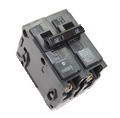Circuit Breaker and Buzzing SoundDaniel, from Long Valley, New Jersey asks:
Dave's Reply:
Hobby Shop PowerI am trying to wire in a small hobby wood shop to my house. I don't need any sort of 220, just typical outlets and lighting, as if wiring in another room of the house. Can you power another sub panel from a spare breaker located in the house's beaker panel? Or do you have to run another separate feed from the meter? Dave's Reply:
|
» Circuit Breakers and Fuses
» Need Electrical Help? Ask the Electrician
15 Amp Circuit Breaker
|
|
Summary: Learn about the 15 Amp Circuit Breaker for home electrical circuits.
© By: Dave Rongey |
15 Amp 120 Volt Single Pole Circuit Breakers
The 15 amp circuit breaker is a common item in a home electrical service panel and can be found at most major hardware stores and electrical wholesale supply houses. This full size breaker is typically less expensive that a twin or a quad style circuit breaker even though it is a 15 amp size. When adding circuits to a panel that is becoming crowded it is sometimes required to install a twin circuit breaker in order to create space for the new circuit. This ITE Siemens brand circuit breaker is a very reliable brand, however just like anything else care must be taken when installing the circuit breaker and making the wire connection at the screw terminal to ensure a solid contact with the electrical panel and the circuit wire conductor.
Characteristics of a 15Amp Breaker15 Amp Circuit Breaker are found in several Home Electrical Panels |
|
|
A Full Size Breaker This full size 1-pole or single pole 15 amp circuit breaker is one that is commonly found in electrical panels of newer homes or homes that have their electrical service panel replaced with a larger and more up to date electrical service. |
|
|
Switching a Breaker On and Off The 15 amp circuit breaker is commonly use for lighting circuits or general purpose outlets where AFCI protection is not required. The full size enables easy operation for switching the circuit on or off. The middle position of the switch handle would indicate that the circuit breaker has tripped off and would need to be reset. |
|
|
The Breaker Connection to the Electrical Panel This brand of 15 amp circuit breaker has a two sided contact surface which help to create a firm connection with the electrical panel buss. These contact surfaces offer maximum contact because of the flat surface area that will slide over the panel buss. |
|
|
The Breaker Wire Terminal The wire terminal of this 15 amp circuit breaker is easily visible allowing the electrician to see the terminal to make sure the wire has been inserted into the terminal. the size of the screw of the wire terminal is a good size to allow easy tightening and the access to the screw terminal is easily accessed, yet the metal parts of the terminal does not stick which keeps the terminal area safe from unwanted contact exposure. |
|
|
Identifying the Type of Circuit Breaker As with any electrical part, this 15 amp circuit breaker is clearly labeled providing full information about the brand, type and application information that may be necessary in order to make the right selection for an electrical circuit project. |
|
Applications with 15Amp Circuit Breakers |
|
Question: Answer: NOTE: This question is based on a specific project. Ask The Electrician provides help for your electrical project: Ask Electrical Questions |
|
The Safest Way to Test Electrical Devices and Identify Electric Wires!The Non-Contact Electrical TesterThis is a testing tool that I have had in my personal electrical tool pouch for years, and is the first test tool I grab to help identify electrical wiring. It is a Non-contact tester that I use to easily Detect Voltage in Cables, Cords, Circuit Breakers, Lighting Fixtures, Switches, Outlets and Wires. Simply insert the end of the tester into an outlet, lamp socket, or hold the end of the tester against the wire you wish to test. Very handy and easy to use.
The Quickest Way to Check for Faulty Electrical Wiring!The Plug-In Outlet TesterThis is the first tool I grab to troubleshoot a problem with outlet circuit wiring. This popular tester is also used by most inspectors to test for power and check the polarity of circuit wiring. It detects probable improper wiring conditions in standard 110-125 VAC outlets Provides 6 probable wiring conditions that are quick and easy to read for ultimate efficiency Lights indicate if wiring is correct and indicator light chart is included Tests standard 3-wire outlets UL Listed Light indicates if wiring is incorrect Very handy and easy to use.
Strip Off Wire Insulation without Nicking and Damaging the Electric Wire!The Wire Stripper and Wire CutterMy absolute favorite wire stripping tool that I have had in my personal electrical tool pouch for years, and this is the tool I use to safely strip electrical wires. This handy tool has multiple uses: The wire gauges are shown on the side of the tool so you know which slot to use for stripping insulation. The end of the tool can be used to grip and bend wire which is handy for attaching wire onto the screw terminals of switches and outlets.. The wire stripper will work on both solid and stranded wire. This tool is Very Handy and Easy to Use. |
||
Circuit Breakers, Panels, Parts and AccessoriesCircuit Breaker Siemens ITE Circuit Breaker ITE GFCI Circuit Breaker ITE AFCI Circuit Breaker Square D Hot Tub Panel Sub Panel 120 240volt 100amp Sub Panel 120 240volt 125amp Panel 120 240volt 200amp |















